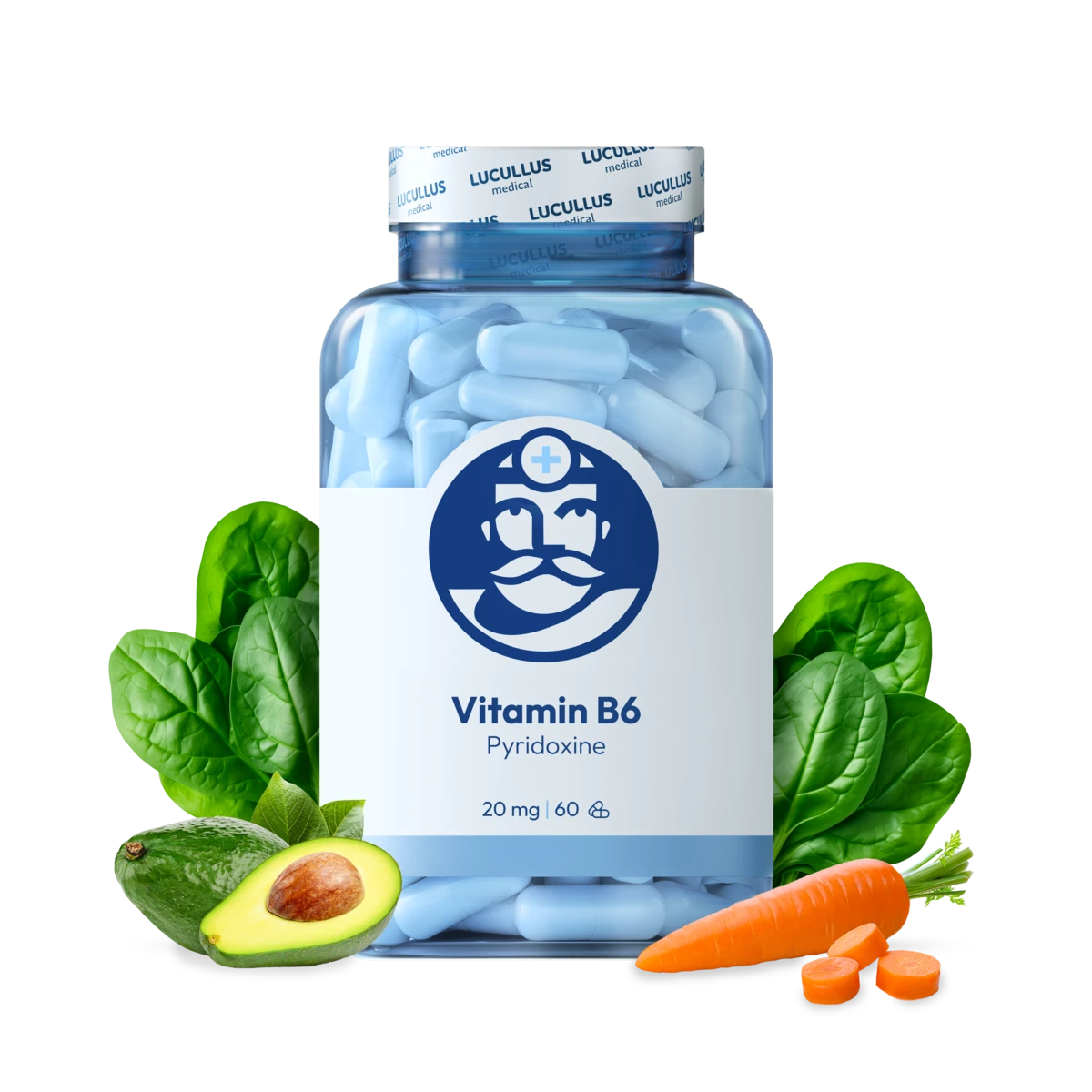
Účinky
Excellent absorption and bioavailabilitySupports optimal muscle function and recoveryImproves nervous system healthSupports strong bones and teethHelps cardiovascular health
Pack of 60 capsules
| Active ingredient | In daily dose | % Ref |
|---|---|---|
| Vitamin B6 (pyridoxine hydrochloride) | 20 mg | 1428.57% |
Ingredients: Vitamin B6 (pyridoxine hydrochloride), bulking agent: magnesium carbonate, microcrystalline cellulose, capsule made from gelatin.
Discover a natural source of vitality and mental balance with pure and effective Vitamin B6
Fatigue, irritability and reduced focus are among the most common signs of vitamin B6 deficiency. This essential micronutrient is crucial for energy production, nervous system balance and proper immune function. Vitamin B6 in capsules provides a precisely dosed, highly absorbable form that supports optimal daily functioning.
Vitamin B6 acts as a coenzyme in more than 100 enzymatic reactions in the body – from amino acid metabolism to glucose regulation. It supports the synthesis of neurotransmitters such as serotonin, dopamine and GABA, influencing mood, memory and sleep quality. It helps convert glycogen into glucose, stabilizing energy levels throughout the day. It strengthens immunity and, thanks to high bioavailability, helps reduce fatigue, stress and supports mental clarity.
Take 1 capsule daily, ideally with food. Manufactured in Slovakia with emphasis on purity, safety and efficacy. It is non-GMO, gluten-free, lactose-free and free of colorants. Each batch is laboratory tested.
Restore your energy and mental freshness. Support your immunity, hormonal balance and emotional resilience naturally – with premium Vitamin B6.

Read the latest news about quality dietary supplements, vitamins, immunity, and health.

For ages, people have been trying to find miraculous herbs and mushrooms that would enhance health, cure deadly diseases, and boost male potency. Each culture has its proven aphrodisiacs. Here, oysters or chocolate are especially well-known. Recently, especially with the development of tourism, we gradually also learn about other invigorating means that people use often on the opposite side of the planet. One of the oldest substances for potency support is Maca Peruvian Watercress.

In addition to vitamins, enzymes, and various supplements, our body also needs so-called trace elements for 100% functionality. The term "trace" means that our body needs it only in small quantities. We need 10 mg of zinc daily, which is 37 times less than magnesium (375 mg). It might seem we're discussing a total non-entity. However, the opposite is true. Zinc affects more than 200 biochemical reactions in our body!

Tribulus terrestris is a small unobtrusive plant with yellow flowers, essentially a weed that has spread from China and Japan all over the world. Today it is even cultivated in gardens for its effects on the human body. It is recognized by Ayurveda and ancient Greek medicine. Abroad, it is known by names such as: goat's head, devil's thorn, burra gokharu, and in Ayurveda as gokshura. It has been used for centuries as a miraculous remedy for infertility, impotence, and erectile dysfunction. It is simply a testosterone booster!

Sometimes it seems at first glance that we have everything under control, but the reality is often different. "Liters" of coffee, fast food between duties, endless deadlines, constantly ringing phones. The result is fatigue, problems with concentration, forgetting even simple things, moods changing faster than the weather, and nights full of tossing and turning, as if our mind is running at a minimum. In a hectic pace, we do not realize the importance of proper nutrition. The good news is that nature can save us, in nature everything can be in harmony if we combine it from nature, it is a mysterious duo of choline and inositol.It is an ideal combination not only for the body but also for a tired mind, which is calling for help. Although many are unaware of them, choline and inositol work in every cell of our body, keeping our brain in shape, liver clean, and nerves strong. Their effects were discovered relatively recently. Why should we pay attention to these nutrients?

Excessive hair loss, slowed growth, or premature graying can have various causes, with diet playing a major role. Para-aminobenzoic acid (PABA), also known as vitamin B10 (although it is not officially a vitamin), is among the significant nutrients that support hair health, skin, and overall vitality of the body. Additionally, it can influence the aging process. Despite its beneficial effects, it is less known today, although in the past it was considered almost a miraculous means of maintaining youth. In the 1950s, scientists studied PABA for its potential in combating degenerative diseases and recorded cases where graying was slowed down.

If you were to test your diet today, you might find that despite healthy eating, you lack enough vitamin B9 - folic acid. Popular avocado toasts are in vogue, but unlike spinach, lentils, or broccoli, they don't contain much B9. Folic acid was first isolated from spinach, and although it is most commonly associated with pregnancy, its importance concerns each of us.